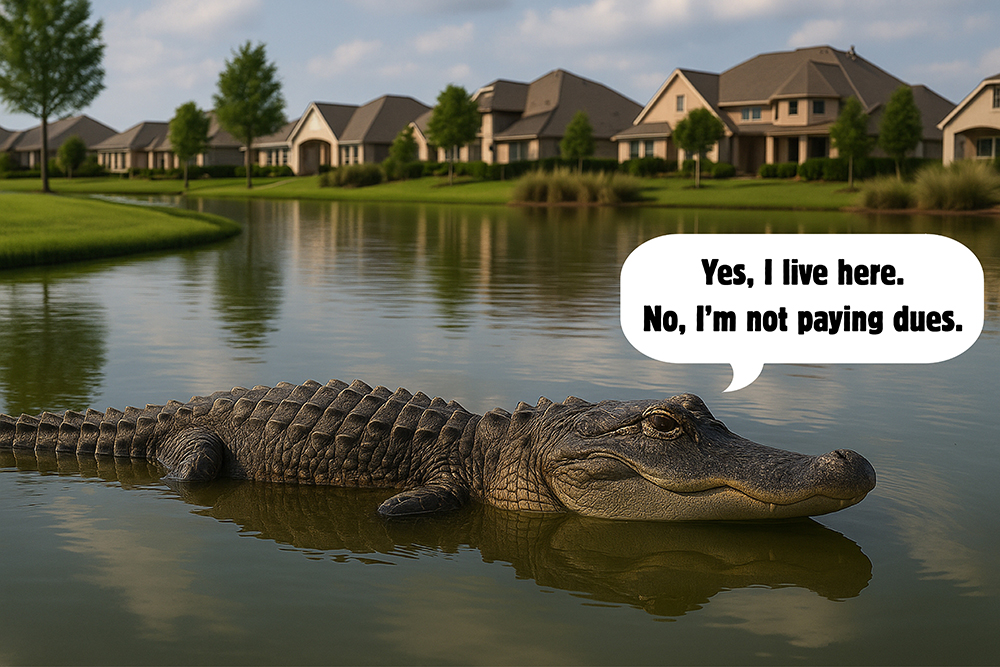
From Lakeside to Curbside: Why Gators Are Wandering Through Katy and Fulshear
In Katy and Fulshear area neighborhoods like Fulshear, waterfront living and easy access to walking trails along nearby creeks are some of the many lifestyle perks. But as summer arrives, residents may also notice an uptick in alligator sightings near creeks, lakes, and bayous—a natural phenomenon tied closely to seasonal behaviors of these wild reptiles.
Though unsettling for some, most alligators pose no danger to humans when left undisturbed. Still, it’s essential for residents to understand why these encounters happen, what typical alligator behavior looks like, and when to call authorities to report a nuisance alligator.
Why You May See Alligators This Summer
The summer months in Katy and Fulshear coincide with increased alligator activity for a number of reasons:
-
Breeding Season: Late spring and early summer mark mating season for alligators in Texas. Males are on the move, sometimes crossing roads or appearing in unfamiliar areas as they search for mates.
-
Warming Temperatures: As cold-blooded reptiles, alligators are more active in warm weather. They're frequently seen basking on the banks of neighborhood lakes, retention ponds, or golf course water features to regulate their body temperature.
-
Rainy Weather and High Water Levels: Heavy rains can flood creeks and bayous, prompting alligators to travel or relocate. This can temporarily bring them closer to homes, walking trails, and community pools built along natural waterways.
So while spotting an alligator can be surprising, it's often part of the natural rhythm of wildlife in areas that back up to Fort Bend County’s many wetland-adjacent neighborhoods.
Common Alligator Behaviors (and What They Mean)
Understanding alligator behavior helps residents determine whether what they’re seeing is cause for concern—or simply part of nature.
-
Basking in the Sun: Alligators often lie motionless on the shore to absorb heat. This is normal and not aggressive behavior.
-
Floating with Eyes and Nostrils Above Water: Gators often float this way to breathe and observe. It doesn’t mean they’re stalking—they’re usually just resting or cooling off.
-
Bellowing or Making Loud Calls: These sounds, mostly heard in spring and summer, are part of mating behavior or territorial displays and are not directed at humans.
-
Hissing or Lunging: This is a defensive warning. If an alligator hisses or lunges, it feels threatened—back away immediately.
Importantly, alligators that appear to approach humans without fear may have been illegally fed, which alters their natural wariness and creates danger for both the animal and people.
Mobile Sidebar Ad
Do’s and Don’ts: Alligator Safety Tips from Texas Parks and Wildlife
Whether you’re walking the dog, enjoying a lakeside trail, or letting children explore, Texas Parks and Wildlife Department (TPWD) offers practical safety tips for avoiding unwanted encounters:
Do:
- Keep a safe distance—at least 30 feet from any alligator.
- Always keep pets on a short leash and away from water’s edge.
- Swim only in designated areas, and avoid swimming at night or in murky water.
- Educate children to observe wildlife from afar.
- Use caution near overgrown banks and under bridges.
Don’t:
- Never feed an alligator. It’s illegal and dangerous.
- Did You Know: Feeding alligators is a Class C misdemeanor punishable by a fine of up to $500.
- Don’t approach, corner, or harass a gator—even small ones.
- Avoid throwing food scraps or fish remains near the water.
- Don’t approach or pick up baby alligators—mom is likely nearby and fiercely protective.
- Non't attempt to remove an alligator from a roadway. Call local authorities for safe removal.
- Don’t assume a still gator is dead—it may be very much alive and resting.
When to Call About a Nuisance Alligator
For the safety of both Fulshear residents and wildlife, it’s important to know when an alligator should be reported. If the alligator isn’t acting aggressively or posing a threat, give it a few days—often up to a week—before calling TPWD. But in some cases, residents might want to pick up the phone sooner. According to TPWD, a “nuisance alligator” is one that:
- Approaches humans or regularly shows up near populated areas.
- Stalks pets or exhibits aggressive behavior.
- Loses its natural fear of people, often due to being fed.
If you believe you’ve seen a nuisance alligator in your Katy or Fulshear neighborhood, contact:
Texas Parks and Wildlife
-
Wildlife Biologist for Fort Bend County: 832-595-8999
-
Wildlife Diversity Biologist for Harris County: 361-576-0022
Officials will assess the situation and take appropriate action, which may include safe and secure relocation of the animal.
Mobile Sidebar Ad
Living Safely with Wildlife in Katy and Fulshear
Living in beautiful, water-rich communities comes with unique benefits—and responsibilities. As development continues in areas like Fulshear, interactions with wildlife like alligators are likely to remain part of the environment.
By staying informed, keeping a respectful distance, and knowing when to report potential dangers, residents can enjoy the natural beauty around them while keeping themselves - and our reptilian friends - safe.
 Tiffany Krenek has been on the My Neighborhood News team since August 2021. She is passionate about curating and sharing content that enriches the lives of our readers in a personal, meaningful way. A loving mother and wife, Tiffany and her family live in the West Houston/Cypress region.
Tiffany Krenek has been on the My Neighborhood News team since August 2021. She is passionate about curating and sharing content that enriches the lives of our readers in a personal, meaningful way. A loving mother and wife, Tiffany and her family live in the West Houston/Cypress region.







